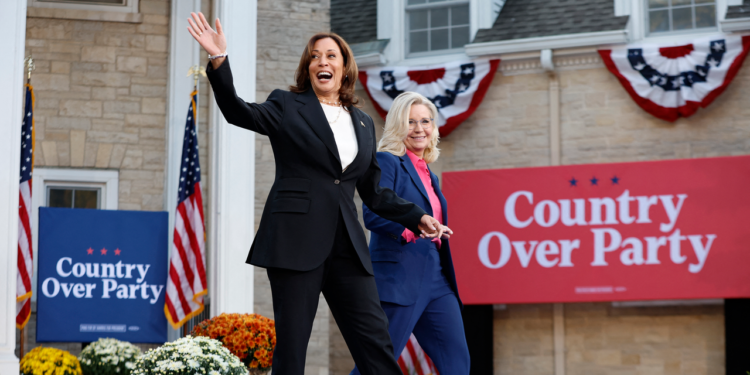It sounds like arcane insider jargon best kept inside a campaign headquarters: Does this election come down to persuasion or mobilization? But the terminology is really just a fancy way of asking whether a campaign should prioritize swaying undecided voters or turning out its base. No matter the rhetoric, though, answering that question is fundamental to every campaign’s chance of winning, and the internal debate will shape the crucial choices Kamala Harris makes in the less than four weeks before a crazy-close presidential election.
See, for example, Harris’s recent appearance in Wisconsin with former Republican congresswoman Liz Cheney and Cheney’s starring role in a new Harris TV ad (running frequently during the Major League Baseball playoffs) aimed at persuadable Republicans. Cheney’s conservative record and policy positions—stridently antiabortion, pro-repealing Obamacare—are anathema to most core Democrats. Yet Cheney emerged as a leading and principled critic of then president Donald Trump in the wake of January 6, and the Harris campaign sees her as a powerful weapon in persuading undecided Republican moderates in swing states to vote against Trump, if not vote completely in favor of Harris. “We are definitely making a play for Republicans and independents and Never Trumpers in a very real way,” a campaign insider tells me. “We are spending a lot of time in red counties—like one third of our offices in Pennsylvania are in Trump counties, rural counties that he won by double digits in 2020. And it’s not necessarily because we think we can win those counties, but because, in a close race, cutting the margins matters.”
That tactic has been part of the Democratic formula all along, even back when President Joe Biden was the Democrats’ 2024 candidate. But the mix between persuasion and mobilization has shifted since Harris suddenly stepped into the top of the ticket in late July. Jen O’Malley Dillon, the chair of Biden’s reelection effort and a master of the complicated blocking and tackling of voter turnout—down to the granular precinct level—had been installing the nationwide infrastructure to replicate her successful work on behalf of Biden in 2020. Harris kept O’Malley Dillon in the same role, and JOD (as she is referred to by staffers) is relentlessly deploying and fine-tuning the mechanisms she put in place during the past year.
But Harris also added David Plouffe, who managed Barack Obama’s 2008 campaign, as a senior adviser. A strategist in touch with Harris’s campaign says Plouffe’s impact is clear. “The Biden campaign had decided this was a turnout election. The Harris campaign thinks it’s a persuasion-and-turnout election, which is classic David Plouffe,” the strategist says. “Besides the Cheney thing, you see it in other ways. The Biden team was never going to talk about immigration. The fact that Harris goes to Arizona to give a speech on immigration, and the fact that they’re trying to own the economic lane exactly like Obama did—David Plouffe is all over that campaign.”
No campaign—at least no successful campaign—is exclusively about one or the other, and the campaign insider argues forcefully that strenuously pursuing both base and undecided voters was always part of the plan, regardless of whether Biden or Harris was the candidate. Harris’s ability to wage an energetic war on both fronts at the same time has been greatly enhanced by the gusher of money, at least $1 billion, that the vice president has raised in less than three months. However, campaign leadership is concerned that the massive haul may not be enough. There will inevitably be tough choices regarding how much money and manpower is devoted to turnout versus persuasion. The calculus is even trickier because Harris’s campaign believes it needs to persuade people not simply to vote for the Democrat, but to vote at all. “We always sort of grouped our targets into two sets,” the Harris campaign insider says. “One is traditional swing targets—folks who are going to vote anyway and it’s a question of us or Trump. The other is what we call ‘persuade to participate.’ They are deciding between the couch and us.”
Reaching the disengaged was one big reason Harris appeared, for instance, on the All the Smoke podcast. And this weekend the persuasion push takes to the skies. The Democratic National Committee will be flying skywriting and banner-trailing planes over stadiums hosting games between six NFL teams from swing states, with messages about “sacking” the right-wing Project 2025 and voting for Harris. But there’s a risk in emphasizing persuasion over mobilization, as base turnout is hardly guaranteed, particularly with issues like Israel and Gaza angering elements of the Democratic coalition. “There are no warning lights, but there are things we need to tighten up,” says Bakari Sellers, a former South Carolina legislator who is close to Harris’s campaign and believes Black and Hispanic men should be the campaign’s focus. “It’s a no-stone-left-unturned strategy—because she can lose a close race, or she can win all six swing states. That’s kind of where it is.”
More Great Stories From Vanity Fair
-
The Menendez Brothers’ Aunt Joan on Why They Must Be Freed: “They Were Used and Abused, and There Seems to Be No End to It”
-
Rudy Giuliani’s Daughter: Trump Took My Dad From Me. Please Don’t Let Him Take Our Country Too
-
The Ballerina Farming of America
-
Melania Trump’s New Book Is Truly Bad, If Jam-Packed
-
Inside the Fight to Release The Apprentice
-
Jennifer Lopez: “My Whole F–king World Exploded” With Ben Affleck Split
-
Get True Colors, an Art World Digest From Nate Freeman, Straight to Your Inbox
-
From the Archive: How the Menendez Brothers’ Murder Turned Family Tragedy Into a Marathon Courtroom Drama
The post Why Kamala Harris Is Making a Play for GOP Voters appeared first on Vanity Fair.



















